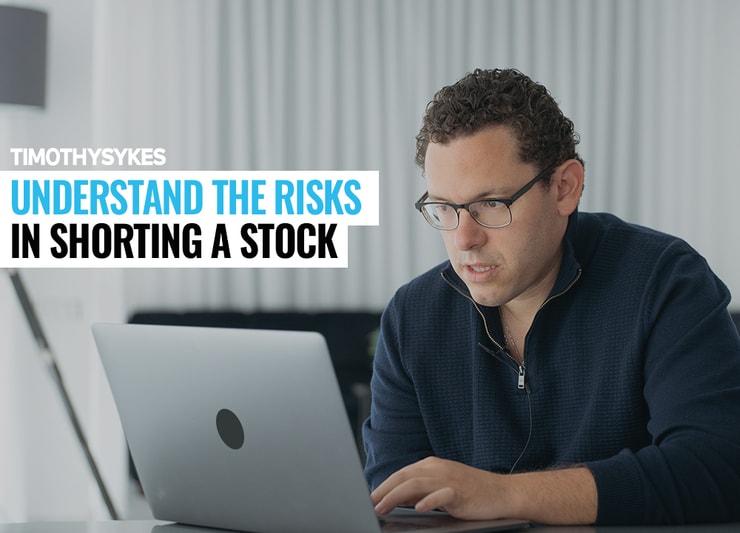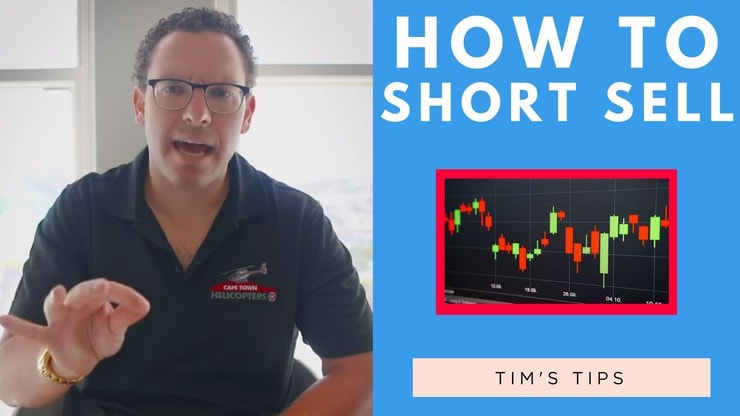Did you know it’s possible to profit from stocks when they go down in price?
Shorting a stock — or short selling — is a trading technique that can help you find opportunities to trade stocks when prices are trending downward.
It might sound strange, but it’s actually very common — and yes, it’s perfectly legal.
In fact, this type of trading inspired the movie “The Big Short.” Of course, that movie is a pretty extreme example. As a new trader, you won’t (and shouldn’t) be taking massive short positions.
But it’s worth your time to learn about short selling because it can expand your ability to find trades in different market conditions.
Before you start shorting, it’s super important to learn the basics — and get familiar with the patterns that can help you spot a good short.
What is short selling? How is it different from going long a stock? How can you use this technique? Let’s go over all of that and more.
Table of Contents
- 1 What Does Shorting a Stock Mean?
- 2 How Does Shorting a Stock Work?
- 3 How Do You Make Money by Shorting a Stock?
- 4 Example of Shorting a Stock
- 5 Pros of Short Selling
- 6 Risks of Short Selling
- 7 Costs of Short Selling
- 8 7 Tips and Considerations for Short Selling
- 9 Trading Challenge
- 10 Frequent Questions About Shorting Stocks
- 11 The Final Word on Short Selling Stocks
What Does Shorting a Stock Mean?

2025 Millionaire Media, LLCoptions. For trading purposes, especially Short selling is where you’re betting against a stock. You believe that the price will go down, so you go through a process of borrowing shares to sell and buy back at a lower price, netting the price difference in profit.
Short selling pretty much turns the traditional “buy low, sell high” trading model on its head.
How Does Shorting a Stock Work?
The idea of short selling might sound weird at first, so let’s break down how it actually works.
First, decide how many shares you want to short, then set out to find shares to borrow.
You’ll have to borrow these from a broker, but be warned: not all brokers offer short selling, and even among those who do, you can’t always find shares to short. That’s why I made this “No Borrow No Cry” video.
Once you borrow those shares, you sell them. Yep! You’re selling shares that are on loan … but (spoiler!) you gotta return them later.
Ideally, you want to sell the shares at a high. For example, it might be a stock that’s currently pumped up price-wise, but without any good reason.
In an ideal world and if the trade goes the way you want, the stock price will start to plummet after you sell them.
More Breaking News
- CNR’s Unexpected Surge: A New Opportunity?
- Sibanye Stillwater: Price Target Concerns and Financial Analysis
- First Majestic Silver (AG): Analyzing the Unexpected Surge
Once the price (hopefully) declines, it’s time to buy back those shares at the lower price. You generally don’t want to hold on too long — things can change fast, or the stock could spike again.
You’ve got to remember this, though: regardless of whether the price goes up or down, you have to buy back the shares and…
Now, you return the shares to your broker, safe and sound. If all went well, you keep the price difference, minus fees.
Sounds easy, right? Yes and no.
Short selling in and of itself isn’t a complicated process. However, learning how to make smart stock picks for short selling can be tricky. Don’t tread lightly when it comes to short selling. We’ll get into the risks in a little bit, but rest assured, they’re significant.
I’d never suggest short selling until you have a really good understanding of the patterns that go into it and a feel for the pace of it. Because when things go wrong with a short sale, they can REALLY go wrong.
Shorting a Stock Versus Buying a Put
If you’re into options trading, the process of short selling might sound a little bit like buying a put option.
And yes, both are bearish strategies. But they’re not the same thing.
With short selling, you’re selling a stock that you borrowed — you don’t own it. When you buy a put option, you gain the right to sell a stock at a specific price that’s higher than what you think the stock will be worth in the near future.
How Do You Make Money by Shorting a Stock?
I know what you really want to know: how can traders make money shorting a stock? Let’s walk through an example.
Disclaimer: The following is only an example and I’m in no way giving you financial advice. All trading and investing is risky. Never risk more than you can afford. Always do your due diligence.
Example of Shorting a Stock
Say that you see a stock trading for $5 per share. But you notice that the company is trading on BS news, and you don’t think that it can hold that price. You think the price will drop soon.
So you hit up your broker and borrow 1,000 shares. You sell them, and the price goes down to $2.
You buy back the shares at $2, then return them to your broker. Before fees, you’ve got about $3,000 in your pocket.
Short Selling for a Profit
In the above example, you get an idea of how a trader can short sell for a profit. The idea is that if you short sell a stock that’s experiencing a high but then decreases in price, you’ve got the potential for profits … But what if the trade doesn’t go well?
Short Selling for a Loss
Here’s where things can get scary with short selling. Say in the above example, you short sell shares of a stock at $5 each. But then, the price starts spiking … and goes up to $15 per share.
You’re still responsible for buying back and returning those shares to your broker. You stand to lose far more than you put into the trade.
Short Selling as a Hedge
In general, the stock markets go up more than they fall. All the same … bear markets are challenging. Fear of loss can lead to plenty of bad decisions.
Having a solid understanding of short selling can allow you to learn to hedge your portfolio, to use a long-short strategy, or to potentially profit from falling markets.
Pros of Short Selling
If you only trade stocks that you hope will go up in price, then you could be missing out on a ton of opportunities.
During a market downturn, for instance, you might just avoid trading.
Personally, I don’t think you should trade every day … only when best setups for your strategy come along. All the same, short selling can increase the number of opportunities you can find during different market conditions.
By adding short selling to your repertoire, you can learn to potentially profit in both bear and bull markets.
I’m not shorting right now, because there are a ton of wannabe short-sellers out there and that’s causing a ton of short squeezes.
But in the past, I’ve been an avid short seller. And if the right opportunity comes along, I might do it again. The key is adapting to and trading based on what’s currently happening in the market — not what you want to happen in the market.
Risks of Short Selling

2025 Millionaire Media, LLCYou may have heard that short selling is risky. Guess what? You heard right.
The biggest risk involved with short selling? Your losses are unlimited. Yes, you heard that right. Unlimited losses.
When you take a long position, the worst case is if the stock drops to $0. Say you bought 1,000 shares at $30 each and the price goes down to $0. That will hurt … but your losses end there.
That’s not the case with short selling.
You could short sell 1,000 shares at $3 and watch the price skyrocket up to $30. In this case, you could lose even more than you put into the trade to begin with.
With a long position, you know exactly how much you could lose. But with short selling, you don’t know. That’s why you MUST do your research … and you MUST be prepared to cut losses quickly!
Costs of Short Selling
There are a few things you should know about the costs associated with short selling.
First, you won’t just find a loser stock and clean up on its free-fall. If a stock falls 10% over the previous day’s close, it’ll be under the alternative uptick rule. This is to keep speculative short selling from forcing prices down further.
Second, there are fees. There will be broker fees for the borrowed shares, and sometimes they fluctuate depending on supply and demand.
Third, as a short seller, you can be taxed at higher short-term capital gains tax rates, regardless of the duration of your position.
Finally, you can’t use the money you make from short selling right away. The money will be deposited in your account, but it won’t be available until your liability to return the shares is in compliance … that usually takes a few days.
7 Tips and Considerations for Short Selling

2025 Millionaire Media, LLCThere’s a lot you need to know if you want to short sell. Here are just a few key tips and considerations.
1. Liquidity
Liquidity matters! Be extremely aware of the liquidity levels when considering any stock, but especially with stocks you want to short.
The lower the liquidity, the harder it is to get in or out of a position. Remember: when you buy, someone has to sell and vice versa. If shares aren’t moving, you can end up in a very uncomfortable position.
2. Margin Account
To take a short position, you’ll most likely need to open a margin account.
This means you might have to put up slightly more capital than if you were just planning on buying stocks. The amount of money you need to open an account will vary based on your broker.
When you utilize margin, your broker will charge you fees for lending you the shares that you want to short. The fees can vary depending on the stock float and the market conditions.
Also, the broker might ask for excess margin … So you might have to deposit extra money or collateral stocks, especially if volatility is high. This is kind of like their insurance policy on the loan they’re giving you since you could lose more than you have in your account.
3. Margin Call
The margin call is every short seller’s worst nightmare.
This means that you need to put more money into your account … but it also means that you have fairly large losses in your account.
By using margin, you’re basically taking out a loan from your broker. If you don’t put more money into your account, the trade will automatically be closed, canceling out your position. You could be stuck with a serious loss.
Wanna know more about margin trading and margin calls? Check out this post.
4. Short Squeeze
Another dreaded event for short-sellers? The short squeeze.
It works like this: If a lot of buyers come in all at once, the stock will shoot up in price. This could happen when a stock has a large number of shares shorted and a catalyst like good news.
Shorts will be rushing for the exit … and longs will be trying to buy up shares like crazy. This phenomenon can be more likely on Fridays. Hype can take over and shorts don’t want to be in losing positions over the weekend. So when shorts buy to cover, it drives the price up. Then longs start buying, driving the price up further.
As a short seller, you’ll inevitably experience this at some point. Be smart about it and cut your losses FAST.
5. Know How to Exit Your Position
You should always have a trading plan for every trade. This is where you determine your entry and exit positions beforehand. With short selling, it’s just as important.
But in addition to knowing when you’ll exit, you need to have an understanding of HOW to exit a short sale.
When you short a stock, you need to “buy to cover” when you want to exit the trade. Many people make the rookie mistake of filling out the trade order form incorrectly. Don’t be one of those jerks.
6. Stop Losses
I never use electronic stop losses. But that’s because I never trade when I can’t watch the trade really closely. Also, my positions are typically short-lived.
But if you plan to leave your computer when you enter a short position, have a stop loss in place.
If you don’t, the stock could rise rapidly, and you risk losing far more money than you ever thought. A stop-loss will automatically exit you from the position if the stock hits a certain level.
7. Dividends
This one may not be relevant to a lot of penny stocks and micro-cap stocks since few of them offer dividends … but it’s still worth knowing if you want to sell short.
If you short a stock at the market close the day before the ex-dividend date, you owe the dividend. This means it will be deducted from your trading account and paid to the person who actually owns the shares.
For example, say you borrow 100 shares of company XYZ, and then company XYZ declares a dividend of 14 cents per share. You need to pay out $14.
It doesn’t seem like a lot, but if you borrow 1,000 or even more shares of XYZ, it becomes a bigger deal.
Trading Challenge
A lot of short-sellers lose money. One big reason is that a lot of them don’t take the time to learn how to trade before they start throwing money at the market.
Don’t make that mistake. Before you put money in the market, be an investor … in your education. If you want to learn the rhythms of the market and get up to speed fast, consider joining my Trading Challenge.
I’m looking for students and traders who want to develop skills and a knowledge base. I want students who strive to become strong, self-sufficient traders.
Your trading mindset is SO important … I only want students who are willing to study and work hard.
I created the Trading Challenge based on my two-plus decades of experience. I want you to benefit from my knowledge and learn what I had to find out the hard way.
I’ve got a ton of resources for you — videos, webinars, and live trading webcasts … plus, you can see every trade I make. And don’t forget: some of my students are teachers, too! Get a solid start with “The Complete Penny Stock Course,” a book by my student Jamil (I wrote the forward).
I don’t want you to memorize patterns. I want you to UNDERSTAND them. This is how you can become adapt to and spot opportunities in any type of market.
Ready to invest in your trading future? Apply for my Trading Challenge today.
Frequent Questions About Shorting Stocks
What is Short Selling a Stock?
Short selling is betting against a stock. You think the stock price will drop.
How does short selling a stock work?
Short selling requires the following steps: Borrow shares to sell from your broker. (Traders pay a fee to borrow shares.); Sell the borrowed shares to open the trade; Buy back, or cover, to close the trade; Return the borrowed shares; Profit or loss is the difference between the sell price and cover price, less fees.
Is shorting a stock legal?
Yes, it’s perfectly legal. Short selling helps the market maintain liquidity.
What is shorting a stock example?
Say you want to short the ticker ZYX. First you borrow shares. Let’s say you borrow and then sell 1,000 shares at $5 each. $5,000 goes into your account. But you owe the broker 1,000 shares of ZYX. To cover, or return the borrow, you buy 1,000 shares of ZYX. If you cover the short below $5, you keep the difference as profit. If you cover above $5, you take a loss.
How long can you short a stock?
There is no specific time limit to shorting, but a broker has the right to buy-in a short. This can happen any time at the discretion of the broker. Buy-ins occur most often when the stock price rises enough that your account doesn’t meet the margin requirement.
The Final Word on Short Selling Stocks
Short selling can be scary and risky … so if you’re going to try this strategy, build your knowledge account first.
Whether you go long or short in the markets, it’s your job to learn and understand as much as you can before you make a single trade.
If you want to short stocks, you gotta be diligent about doing your research. You also need to learn how to recognize key patterns and get a good grasp of how the process actually works. Reading this post is a good start. But your education is far from over. Keep it going strong every day — your market education never really ends.
And if you’re ready to dedicate yourself to learning the process, consider applying for my Trading Challenge. Knowledge is power when it comes to trading, and that’s especially true for short selling.
I want to know what you think … Do you short sell stocks? Why or why not?









Leave a reply